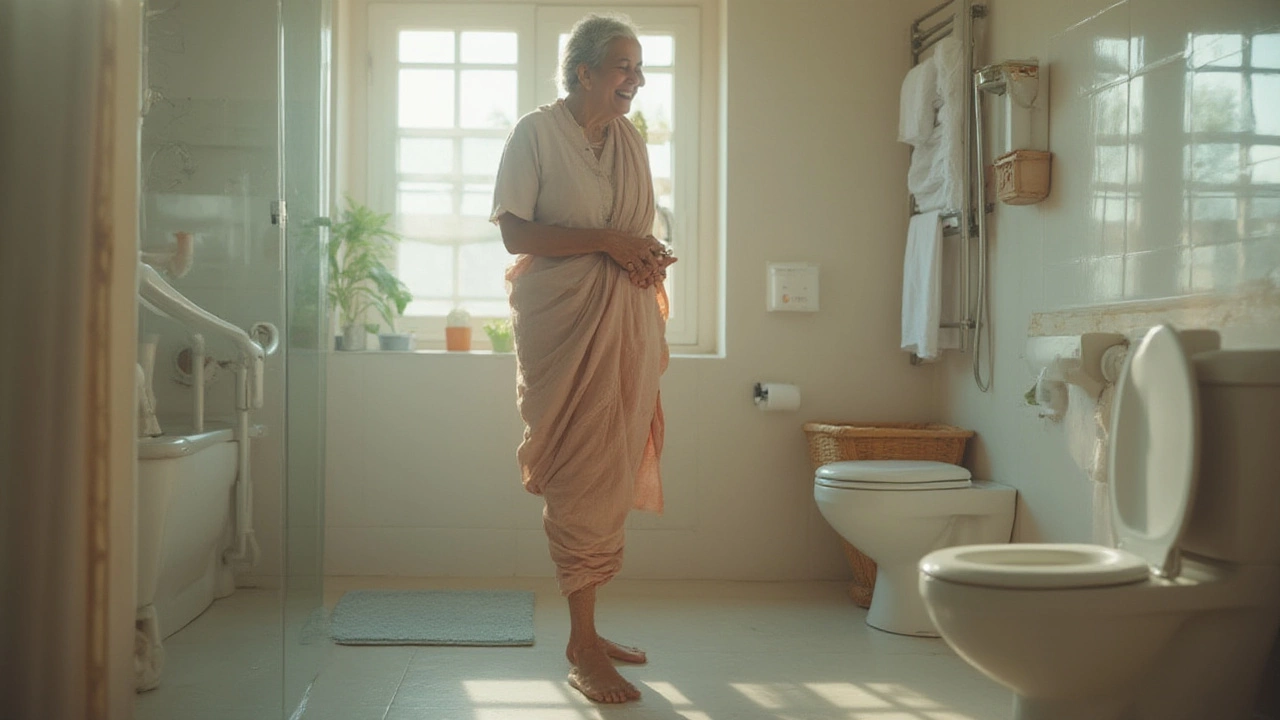Trust me, nothing feels more urgent than the need to use the bathroom when your knee is fresh out of surgery and your independence took a nosedive. No one likes admitting that just standing up or shuffling across the floor suddenly seems as hard as a triathlon. Yet, for most people who’ve just had knee surgery, this is the honest new reality. It doesn’t matter if you had a minimally invasive arthroscopy, a total knee replacement, or something in between; every move matters, and a simple bathroom break turns into a full-on, well-orchestrated mission. Many folks are totally unprepared for how this basic need changes right after the operation. So, let’s lay it all out—no dodging or sugarcoating.
How Soon Can You Go to the Bathroom Alone After Knee Surgery?
One big question everyone has after knee surgery: How quickly can you go to the bathroom by yourself? The short, unsatisfying answer is: it depends. The type of knee surgery you had makes a massive difference. People recovering from minor arthroscopic procedures might walk with a bit of a limp the next day, while folks who just got a full knee replaced may not even want to see stairs for weeks. Hospitals now encourage “early mobilization,” meaning they want you up and moving—sometimes the very same day as the operation. But, moving to the bathroom by yourself is about much more than just standing up.
For most patients, you can expect supervised bathroom trips in the first 12 to 24 hours after knee surgery. Nurses or physiotherapists usually help you stand, move to a walker, and slowly shuffle to the toilet. Some people (especially younger, healthier folks or those with top-notch muscle strength before surgery) might manage to use the bathroom independently after 24 to 48 hours. Others, especially if you’re older, had complications, or feel dizzy from medication, should not rush it.
Falls are a huge risk after knee surgery—the statistics don’t lie. A study from the Journal of Arthroplasty (2023) found that about 3% of patients fall during their first week after knee replacement, and a big chunk of those falls happen in the bathroom. Why? The bathroom is slippery, space is tight, and you’re often in a hurry. That’s a recipe for disaster when your balance is off.
If you live alone, you may worry more. Many hospitals keep patients overnight, not just for pain control but to gauge your mobility and safety in real-life situations. They’ll likely ask you to show you can safely get in and out of bed, walk, and make a bathroom trip before sending you home.
There are practical things you can do before surgery to smooth your first solo bathroom journey: set up a clear path, remove throw rugs, and install grab bars if your bathroom doesn’t have them. This upfront prep saves you from those “oh no, I wish I thought of this earlier” moments. Remember, it’s perfectly normal and smart to ask for help for those first few toilet runs. Pride has no place when your new knee could cost you a fall.
What Makes Going to the Bathroom So Challenging Post-Surgery?
The struggle is real: stiffness, pain, and swelling make it nearly impossible to bend your knee. Painkillers can make you groggy or even a little unsteady. Add bulky dressings, crutches, or a walker, and going to the bathroom suddenly feels like a military obstacle course. Every movement—from getting out of bed, using a walker, sitting down, and standing up—uses muscles and joints that have just been disturbed or replaced.
Let’s break down what actually slows you down:
- Swelling and pain: Your knee might double in size and any shift sends a jolt through your body. Patients often say the knee “feels foreign.”
- Mobility aids: You’ll likely be on a walker, crutches, or even a wheelchair at first. Before you master balancing and coordinating these, transferring to the toilet can get awkward.
- Bathroom setup: Standard toilets are low. Sitting and standing up after knee surgery can feel impossible, unless you’re using a raised toilet seat. Small bathrooms mean you don’t have room to maneuver your aids. Plus, wet floors can be a nightmare.
- Dizziness: Medication and sudden changes in position can make your blood pressure drop. The result? You stand up too fast, get dizzy, and boom…hospital staff have seen it all.
- Hygiene risks: Getting up to wash up after using the toilet might sound simple, but bending or twisting that knee is off-limits. Many folks use long-handled tools or sit-down showers for a while.
No surprise, people sometimes hold their bladders way too long after surgery, which isn’t healthy. It can even lead to a urinary tract infection. Don’t do it. Ask for help if you need it. Nurses have special gadgets like bedside commodes, urinals, or absorbent pads for a reason.
| Difficulty | Statistical Impact on Recovery | Tools/Help Needed |
|---|---|---|
| Swelling/Pain | Delays walking by an average of 2-3 days | Ice packs, pain meds, walker |
| Dizziness | Sudden drops lead to falls in 8% of post-op patients (source: AORN, 2022) | Assistance on first walks, frequent monitoring |
| Bathroom Layout | Small spaces double the risk of falls vs. accessible bathrooms | Grab bars, raised toilet seat, clutter-free path |
If there’s just one thing you walk away with, make it this: the bathroom can be as dangerous as a patch of ice in winter. Plan ahead with the right gear and support.

Tips For Safe and Independent Bathroom Trips After Knee Surgery
Regaining your independence doesn’t happen overnight, but a few clever tweaks can put you back in control faster. First, make your bathroom surgery-friendly. A raised toilet seat is a total game changer. It keeps your knee from bending too much and makes sitting and standing up less painful. Grab bars (even the stick-on kind from the hardware store) give you something stable to hold onto. If you’re dealing with a tiny restroom, move anything you could trip over—bathmats, bins, and even your cat’s litter box (Bella, I’m looking at you!).
In the first days after surgery, ask loved ones or your care team to give you an arm on those first few walks to the bathroom. Even if you feel stubbornly independent, you’re still at risk of wobbly legs or sudden dizziness. Don’t be shy—this is a short-term thing.
As you get steadier, practice standing from seated positions several times a day, ideally with someone around. Your nurse or physiotherapist can show you the best way to push up without torquing your knee. A simple motion: put both hands on the armrests or stable surfaces, push down with your arms, and keep weight off the healing knee as you stand.
People underestimate how important clothing is here. Fancy trousers with zippers and buttons aren’t your friends—switch to loose pants or shorts that are easy to pull up and down, especially when you’re groggy or hurting.
Your post-surgery pain meds can be constipating. Hydrate, eat fiber-rich foods, and maybe stock some gentle laxatives. Nobody wants their first bathroom trip after knee surgery to be memorable for the wrong reasons.
- Install night lights so you don’t risk a misstep in the dark.
- Position a chair in the bathroom if you’re worried about standing too long.
- You might be sent home with a commode you can keep bedside till you’re more confident.
- Try keeping a hand sanitizer nearby for easier cleanup when it’s harder to get to the sink.
- Keep your phone close, in case you need to call for help but don’t shout across the whole house at 2 a.m.
Here’s a neat little checklist for your first few weeks, to keep the risk of mishaps as low as possible:
- Clear the path to your bathroom—no rugs, cords, or stray shoes.
- Use your walker or crutches every time, even for “quick” trips.
- Sit before you feel tired, not after.
- If you’re dizzy, sit and call for help—don’t power through.
- Keep all your grab bars and raised seats in place till your doctor or physiotherapist says you’re ready to work without them.
Some folks recover crazy fast; others need more time. Your physical therapist knows what’s realistic for you. And hey, if you have pets like Bella the cat, watch out—curious animals love wandering underfoot at exactly the worst moment. I’ve learned this the fun way more than once!
When to Ask for Help and What to Expect As You Heal
Here’s the truth: even the most independent person sometimes needs a helping hand after knee surgery. This isn’t a sign of weakness; it’s just good sense. Most of the bad stories I’ve heard—from patients who tried to tough it out and fell—start with someone insisting they could manage the bathroom alone before they were ready. Don’t let pride get in the way; accept help when you need it, especially for the first week.
For some people, especially those with a history of falls or balance issues, the doctor may recommend outpatient support or even a short stay at a rehab facility. Insurance companies actually track how soon people get back to independent bathroom use—it’s considered a marker of successful recovery. The faster you do it safely, the faster you might go home. But “safe” always beats “fast.”
Every day you’ll do a little more. First, you’ll walk with help, then maybe with a walker, and soon you’ll feel comfortable shuffling to the bathroom alone. You’ll stop worrying whether a sudden cough or sneeze will send you toppling. Little milestones, like managing to brush your teeth or use the toilet without support, become big victories after surgery.
Still, even weeks after surgery, you might notice some awkward moments. Maybe your bathroom routine takes longer. Maybe the swelling and stiffness linger, especially in the morning. Celebrate progress, not perfection. If you start to notice odd sensations—numbness, pins and needles, or the wound looking red or leaking—call your surgeon’s office. Anything that makes it harder to move or sit is worth bringing up.
One overlooked part: after-effects of anesthesia and pain medications can cause trouble using the loo for the first couple of days. If you struggle to pee or can’t have a bowel movement after day two, speak up. This isn’t rare, and doctors have ways to help. Don’t sit and suffer in silence (literally and figuratively).
Most doctors say you’ll get back to fairly normal bathroom independence within a week or two if you follow your recovery plan and don’t try to play superhero. If you had both knees done at once, or your home has tricky stairs, that timeline stretches out—plan accordingly with commodes or helpers.
With some prep, patience, and the right attitude, you’ll soon look back at your post-surgery bathroom adventures and laugh. Until then, use every resource to keep safe, ask questions, and give yourself grace. Even a wobbly step is a step forward. And remember, if your cat (like Bella does) tries to "help" by weaving by your feet, gently persuade them to supervise from a safe distance.





